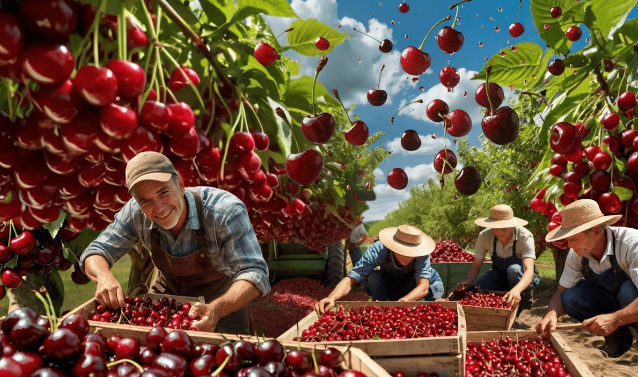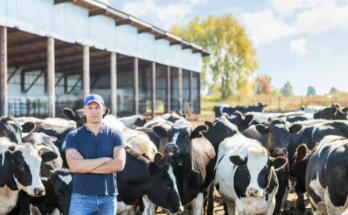These videos are an in-depth exploration of cherries – from their origins, popular varieties, to sustainable farming and harvesting techniques. Cherry not only captivates with its charming color and sweet taste, but also contains significant nutritional benefits and economic value. In addition, today’s videos also provide detailed instructions on the preservation and packaging process, helping to maintain the freshness and highest quality of cherries when they reach consumers. This is a great resource for those who want to better understand this unique fruit and how it is cared for, harvested, and professionally preserved.

**Secrets of Growing and Preserving Cherries: Harvesting and Farming Considerations**
Growing and preserving cherries requires a combination of careful attention to timing, techniques, and resources. Cherries, a beloved fruit known for their sweetness and versatility, are grown in a variety of climates, but they thrive best in regions with cold winters and moderate summer temperatures. Successful cherry farming involves understanding the specific needs of cherry trees, from soil conditions to pollination and harvest timing, while also ensuring that the fruit is preserved properly to maintain its quality after harvest.
**Growing and Harvesting Cherries**
Cherries are typically grown in orchards, and the process of planting begins with choosing the right cherry variety suited to the local climate. There are two main types of cherries: sweet cherries (like Bing and Rainier) and tart cherries (like Montmorency). Sweet cherries are often eaten fresh, while tart cherries are commonly used for processing into products like jams, jellies, and pies.
The growing process requires careful attention to soil quality, watering, and pruning. Cherry trees need well-drained soil with a slightly acidic pH. They also require a period of winter chill to promote bud development, so they are often planted in temperate zones. During the growing season, cherry trees need regular watering, especially in drier climates, but care must be taken not to overwater as this can lead to root rot. Pruning is essential to remove dead or overcrowded branches, allowing sunlight to reach the fruit and improving airflow to prevent diseases.
The timing of the harvest is crucial for cherries, as the fruit must be picked at its peak of ripeness. Unlike some fruits, cherries do not continue to ripen after being picked, so farmers must monitor their orchards closely to determine the optimal harvest time. Cherries are typically harvested in late spring or early summer, depending on the region and variety. Harvesting is usually done by hand to prevent damaging the delicate fruit, with workers carefully picking each cherry off the stem to avoid bruising.
**Preserving Cherries and Reducing Waste**
After cherries are harvested, preserving the fruit is essential to prevent spoilage and extend shelf life. There are several methods for preserving cherries, including freezing, canning, and drying. Freezing is one of the most common methods, as it helps maintain the fruit’s texture and flavor. For freezing, cherries are typically pitted and placed in airtight containers to prevent freezer burn. Canning, on the other hand, involves preserving cherries in syrup or juice, which can be stored for longer periods. Dehydrating cherries, whether through air-drying or using a dehydrator, results in dried fruit that can be stored for months and is a popular method for making snacks and preserves.
**Budget, Spending, and Release Date for Cherry Farming**
The successful cultivation and preservation of cherries require significant investment, especially for large-scale orchards. Cherry farming involves costs for land preparation, planting, irrigation systems, labor for pruning and harvesting, and investment in machinery or packaging materials for preserving the fruit. Farmers may also need to invest in cold storage facilities for preserving cherries after harvest.
Government funding and grants play a crucial role in supporting cherry farmers. In many regions, agricultural programs offer financial assistance to help farmers invest in new technologies, improve farm infrastructure, and manage risks related to climate change or labor shortages. For example, in the United States, the U.S. Department of Agriculture (USDA) provides grants and low-interest loans to farmers for implementing sustainable practices, such as water-saving irrigation systems, or for purchasing equipment like sorting machines and cold storage units.
The **release date for funding** varies, but these budgets are often announced at the beginning of the fiscal year, giving farmers a chance to apply for subsidies or support programs. Timely access to financial assistance helps farmers plan for the growing season, manage operational costs, and invest in technology to increase yield and reduce waste. Additionally, funding may be directed toward research and development for pest control, sustainable farming techniques, and market access for preserving cherries in a competitive global market.
**Success of Cherry Farming and Resources for Farmers**
The success of cherry farming hinges on several factors, including the ability to maintain high-quality fruit, manage labor effectively, and adopt sustainable practices. Farmers who are able to reduce waste through better preservation techniques, like freezing or canning, can increase their profitability by extending the shelf life of their fruit. Moreover, using advanced technology such as precision agriculture tools can help farmers optimize irrigation, monitor soil health, and reduce resource usage, ultimately leading to higher yields and better financial outcomes.
Farmers can also benefit from various resources available to them through industry associations, government programs, and cooperative efforts. These resources can include technical training, marketing support, and access to research about best practices for growing and preserving cherries. Agricultural cooperatives may offer shared equipment, bulk purchasing options for supplies, and collective marketing strategies that improve access to larger markets for processed cherry products.
In conclusion, the success of cherry farming and preservation relies on strategic planning, investment in technology and infrastructure, and access to funding that supports sustainable and efficient farming practices. By combining good cultivation techniques, careful harvesting, and innovative preservation methods, cherry farmers can ensure a steady supply of high-quality fruit while meeting the demands of consumers both fresh and processed. With the right resources and support, the cherry industry can continue to thrive and expand.




